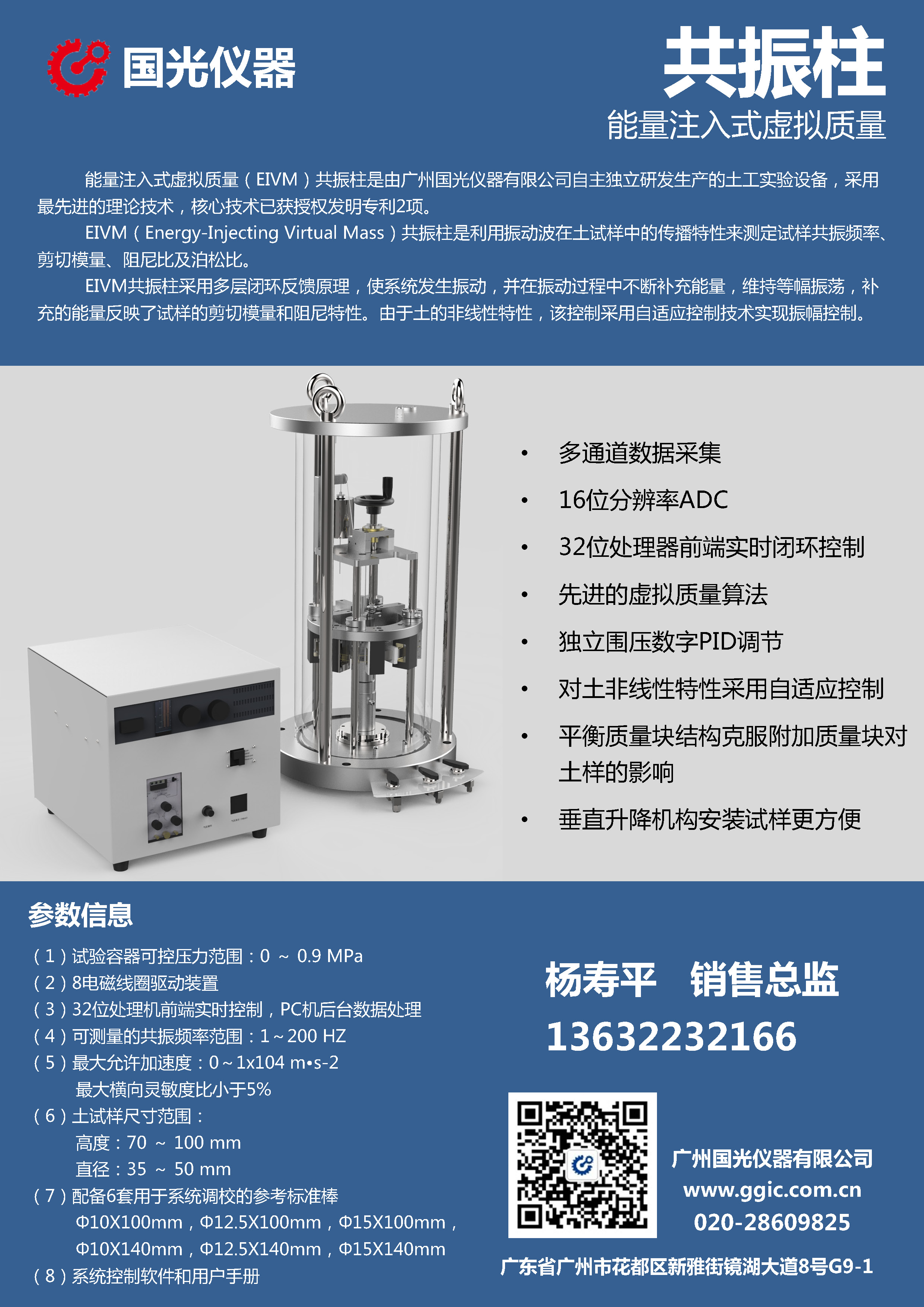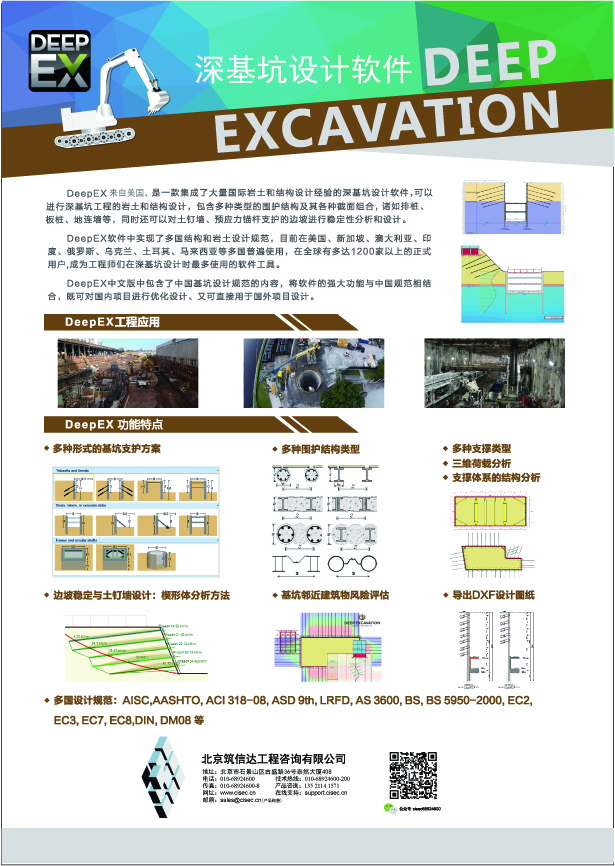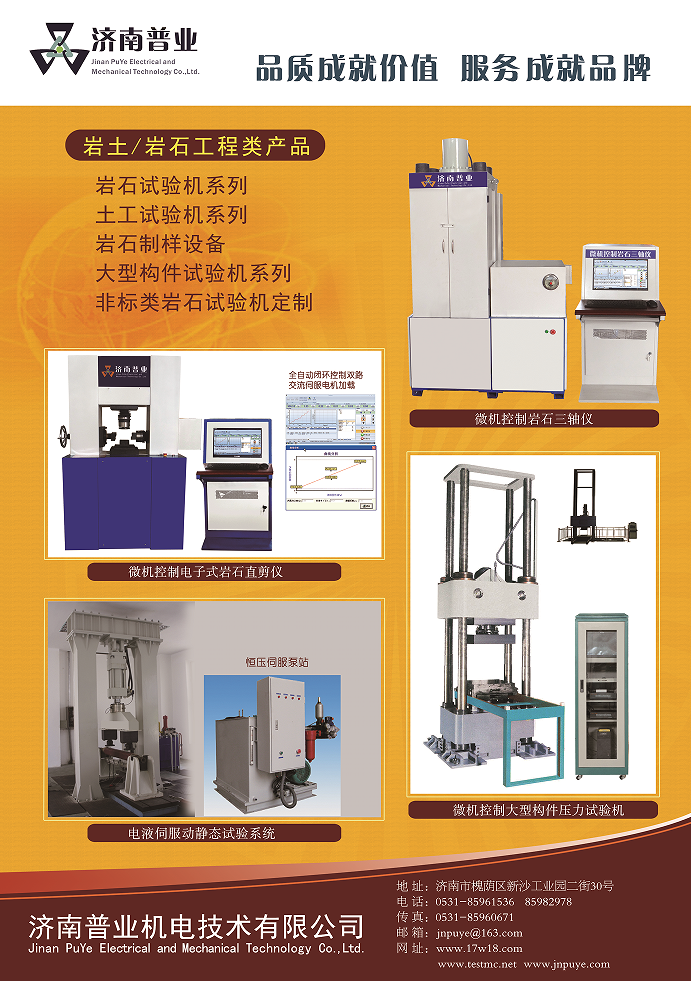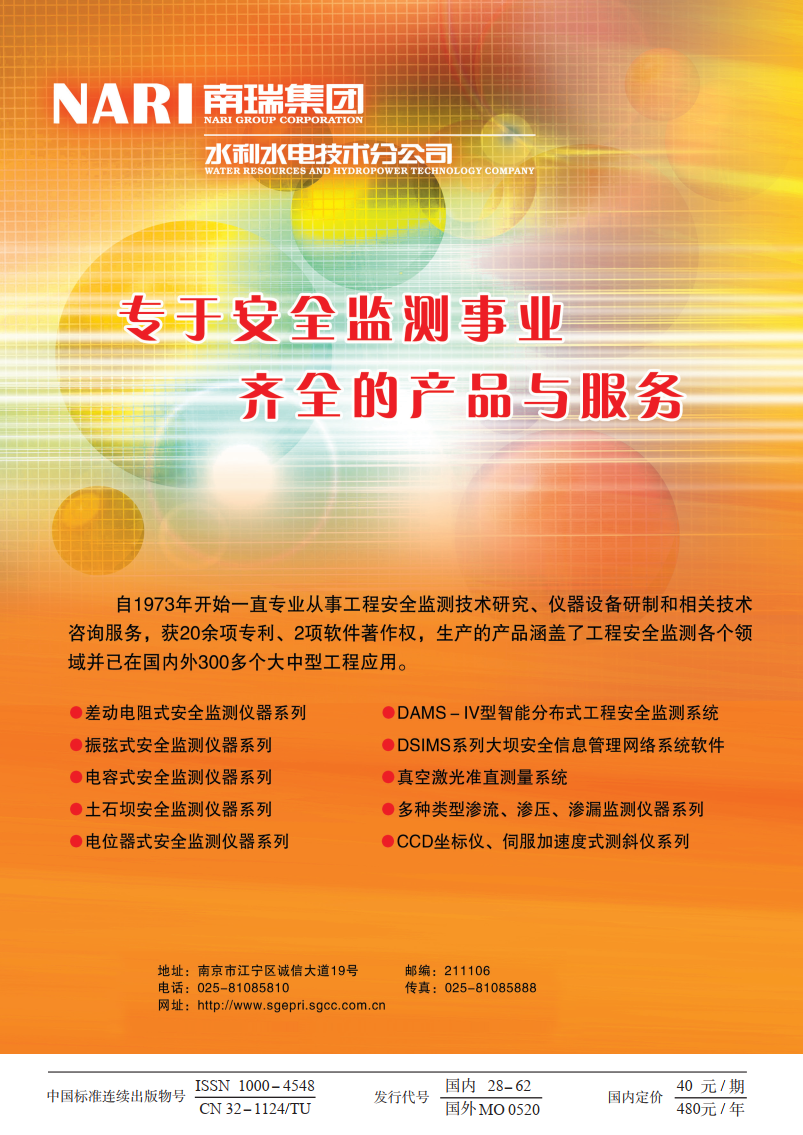Stability analysis methods for strain-softening slopes
-
摘要: 对于具有应变软化特性的岩土质边坡,如果按照峰值强度进行设计与分析,会遗留安全隐患;如果取残余强度分析,则会增加工程成本,造成不必要的浪费.因此考虑应变软化的边坡稳定性分析方法对于此类边坡的评价与治理具有重大的意义.首先基于岩土体的应变软化本构借助FLAC软件实现了边坡的渐进性破坏过程模拟;其次基于最大剪应变增量确定了边坡的滑面;基于滑面上强度参数的时空分布规律借助Matlab软件平台实现了基于矢量和法的应变软化边坡稳定性分析;然后基于材料参数沿滑面的空间分布规律提取了等效黏聚力和等效内摩擦角,并借助极限平衡法分析了边坡在渐进性破坏过程中滑面及安全系数的变化过程,用于补充上一种方法在坡体未产生明显破坏时的不足;最后将两种不同的应变软化边坡稳定性分析方法对应计算结果进行对比分析,验证了两种方法的合理性及可靠性,同时两种方法形成相应的互补关系,很好地解决了应变软化边坡稳定性的分析问题.Abstract: Designing and analyzing the rock-soil slope with strain-softening behaviors according to the peak strength tends to cause potential safety hazards, while that according to the residual strength tends to increase costs. The stability analysis methods for slopes considering strain-softening behaviors are of great significance. Based on the strain-softening constitutive relation, the progressive destruction of a slope is simulated in FLAC first. Then the slip surface is determined by the maximum shear strain increment. The vector sum method for stability analysis of the strain-softening slope is accomplished by Matlab based on the temporal-spatial distribution of strength parameters on the slip surface. The equivalent cohesion and internal friction angle are extracted from the spatial distribution of strength parameters of the slip surface. The limit equilibrium method is implemented to analyze variation of the slip surface and safety factor during the progressive destruction to supplement the drawback of the vector sum method. The results of the two methods for the stability analysis of strain-softening slopes are compared, and their reasonability and reliability are validated. The two methods show a complementary relationship in solving the stability problem of strain-softening slopes.
-
[1] 沈珠江. 理论土力学[M]. 北京: 中国水利水电出版社, 2000: 291-322. (SHEN Zhu-jiang. Theoretical soil mechanics[M]. Beijing: China Water & Power Press, 2000: 291-322. (in Chinese)) [2] LAW K T, LUMB P. A limit equilibrium analysis of progressive failure in the stability of slopes[J]. Canadian Geotechnical Journal, 1978, 15(1): 113-122. [3] SRBULOV M M. A simple method for the analysis of stability of slopes in brittle soil[J]. Soils and Foundations, 1995, 35(4): 123-127. [4] YAMAGAMI T, TAKIMAZAKA Z and JIANG J. Progressive failure analysis of slopes based on LEM[C]// Performance and Evaluation of Soil Slopes under Earthquake and Rainstorm. Dalian: [s. n.], 1998: 35-48. [5] 吕铁墩. 应变软化土坡稳定极限平衡分析[D]. 杭州: 浙江大学, 2007. (LU Tie-dun. Limit equilibrium method applied to slope stability analysis of brittle soil[D]. Hangzhou: Zhejiang University, 2007. (in Chinese)) [6] 张 嘎, 张建民. 基于瑞典条分法的应变软化边坡稳定性评价方法[J]. 岩土力学. 2007, 28(1): 12-16. (ZHANG Ga, ZHANG Jian-min. Stability evaluation of strain-softening slope based on Swedish slice method[J]. Rock and Soil Mechanics. 2007, 28(1): 12-16. (in Chinese)) [7] ZHANG Ke, CAO Ping, BAO Rui. Progressive failure analysis of slope with strain-softening behaviour based on strength reduction method[J]. Journal of Zhejiang University-Science A (Applied Physics & Engineering), 2013, 14(2): 101-109. [8] 何忠明, 吴 维, 付宏渊, 等. 基于应变软化模型的软岩高边坡过程稳定性研究[J]. 中南大学学报(自然科学版), 2013, 44(3): 1203-1208. (HE Zhong-ming, WU Wei, FU Hong-yuan, et al. Process stability of soft rock high slope based on strain softening model[J]. Journal of Central South University (Science and Technology), 2013, 44(3): 1203-1208. (in Chinese)) [9] 孟凡理, 徐 亮, 徐 威. 考虑岩土体应变软化效应的边坡稳定性分析方法[J]. 大坝与安全, 2013(4): 39-42. (MENG Fan-li, XU Liang, XU Wei. A new stability analysis method of strain softening slope[J]. Dam and Safety, 2013(4): 39-42. (in Chinese)) [10] Itasca Consulting Group Inc. FLAC3D: Fast lagrangian analysis of continua in 3 dimensions user manual (Version 3.0)[M]. Minneapolis, 2005. [11] 刘艳章, 葛修润, 李春光, 等. 基于矢量法安全系数的边坡与坝基稳定分析[J]. 岩石力学与工程学报, 2007, 26(10): 2130-2140. (LIU Yan-zhang, GE Xiu-run, LI Chun-guang, et al. Stability analysis of slope and dam foundation based on vector method safety factor[J]. Chinese Journal of Rock Mechanics and Engineering, 2007, 26(10): 2130-2140. (in Chinese)) [12] 郭明伟, 葛修润, 李春光, 等. 基于矢量和方法的边坡稳定性分析中整体下滑趋势方向的探讨[J]. 岩土工程学报, 2009, 31(4): 577-583. (GUO Ming-wei, GE Xiu-run, LI Chun-guang, et al. Study on potential sliding direction in slope stability analysis based on vector sum method[J]. Chinese Journal of Geotechnical Engineering, 2009, 31(4): 577-583. (in Chinese)) [13] 郭明伟. 边坡与坝基抗滑稳定矢量和分析法的研究及工程应用[D]. 武汉: 中国科学院武汉岩土力学研究所, 2010. (GUO Ming-wei. Study on the vector sum analysis method of slope and dam foundation stability against sliding and its engineering application[D]. Wuhan: Chinese Academy of Sciences, Institute of Rock and Soil Mechanics, 2010. (in Chinese)) [14] 李 剑, 陈善雄, 余 飞. 基于最大剪应变增量的边坡潜在滑动面搜索[J]. 岩土力学, 2013, 34(增刊1): 371-378. (LI Jian, CHEN Shan-xiong, YU Fei. A method for searching potential failure surface of slope based on maximum shear strain increment[J]. Rock and Soil Mechanics, 2013, 34(S1): 371-378. (in Chinese)) [15] POTTS D M, ZDRAVKOVIC L. Finite element analysis in geotechnical engineering application[M]. London: Thomas Telford, 2001: 125-163. [16] CONTE E, SILVESTRI F, TRONCONE A. Stability analysis of slopes in soils with strain-softening behaviour[J]. Computers and Geotechnics, 2010, 37: 710-722. -
期刊类型引用(39)
1. 侯振坤,陈炫霖,唐孟雄,凌造,都喜东,徐峰,贺绍阳,梁仕华. 预应力混凝土管桩桩端侧后注浆理论及承载特性研究进展综述. 河南理工大学学报(自然科学版). 2025(01): 154-165 .  百度学术
百度学术
2. 钟宏伟,秦鹏飞,卢再光,张颖. 富水砂土隧道注浆加固效果评价研究:以郑州地铁7号线砂土隧道为例. 西北地质. 2025(01): 315-322 .  百度学术
百度学术
3. 马宇佳,孙超,赵一恺,陈宇轩,何佳乐. 中砂介质注浆加固效果研究. 浙江建筑. 2025(01): 80-83 .  百度学术
百度学术
4. 秦鹏飞,陈涛,周想云. 砂质隧道复合注浆加固技术与其应用研究. 中国农村水利水电. 2025(03): 136-141+147 .  百度学术
百度学术
5. 李海燕,夏茂哲,张锟,张波,孙怀凤,赵国东,韩俊飞,刘功杰,贺恩磊. 岩溶凹陷式露天矿山大流量涌水治理技术. 煤炭科学技术. 2024(01): 267-279 .  百度学术
百度学术
6. 秦鹏飞,钟宏伟. 地铁隧道砂土劈裂注浆加固机理分析. 城市轨道交通研究. 2024(03): 30-36+42 .  百度学术
百度学术
7. 马广兴,王东杰,陈立伟,边乐. 穿层钻孔帷幕注浆一体化技术的实践研究. 矿业研究与开发. 2024(04): 144-151 .  百度学术
百度学术
8. 秦鹏飞. 高聚物注浆技术及其应用研究. 黄河科技学院学报. 2024(05): 56-63 .  百度学术
百度学术
9. 莫浩,侯晓萍,赵卫全,黄勇. 迂曲度对盾构隧道管片注浆的影响. 科学技术与工程. 2024(17): 7319-7326 .  百度学术
百度学术
10. 秦鹏飞,张颖,王柳舒. 非均质砂土劈裂注浆加固机理分析. 力学与实践. 2024(03): 609-616 .  百度学术
百度学术
11. 易四海,仲锐,景胜强,朱伟,王越. 孔隙介质孔隙率对注浆改造影响的试验研究. 中国矿业. 2024(S1): 278-283 .  百度学术
百度学术
12. 余永强,张程鑫,张纪云,范利丹,唐金召,苏洲虎. 砂土介质注浆扩散规律试验研究. 金属矿山. 2024(07): 66-74 .  百度学术
百度学术
13. 张华磊,徐保杰,王开伟,束云龙. 不同粒径分布多孔介质的幂律流体渗透注浆机制. 采矿与安全工程学报. 2024(05): 1025-1035 .  百度学术
百度学术
14. 侯晓萍,莫浩,赵卫全,黄勇. 基于分形理论的多孔介质渗透注浆机制. 长江科学院院报. 2024(09): 106-113 .  百度学术
百度学术
15. 邓重青,李永雷,高玉超. 煤矿薄基岩区底砾层水害治理技术研究与应用. 山东煤炭科技. 2024(09): 152-157+163 .  百度学术
百度学术
16. 施凌瑞,李宝华,雷明林,王国萍. 富水半成岩隧道处治方案研究. 价值工程. 2024(30): 50-53 .  百度学术
百度学术
17. 秦鹏飞,王文菁. 基于渗滤效应的砂土注浆扩散机理分析. 中国水利水电科学研究院学报(中英文). 2024(06): 623-631 .  百度学术
百度学术
18. 易四海,仲锐,景胜强,王越,朱伟. 注浆压力对孔隙介质注浆改造效果影响的试验研究. 华北科技学院学报. 2024(06): 1-6 .  百度学术
百度学术
19. 秦鹏飞,朱翔,周想云. 基于分形理论的裂隙岩体渗透注浆机理研究. 煤炭学报. 2024(S2): 845-851 .  百度学术
百度学术
20. 秦鹏飞,孙洪硕,陈晓红,杨光,梁一星. 考虑砂土压密特性的劈裂注浆机理分析. 实验技术与管理. 2023(01): 31-37+43 .  百度学术
百度学术
21. 刘万光. 强采动大巷破碎煤柱水泥基浆液注浆渗透扩散规律研究. 科技和产业. 2023(01): 192-196 .  百度学术
百度学术
22. 朱定桂,施成华,孙晓贺,肖国庆,安斌. 考虑迂曲度的水泥-水玻璃双液浆柱形渗透机制研究. 铁道科学与工程学报. 2023(05): 1800-1809 .  百度学术
百度学术
23. 秦鹏飞,钟宏伟,刘坚,苏丹娜,孙卓宇. 考虑浆土应力耦合作用的劈裂注浆机理分析. 西南交通大学学报. 2023(03): 584-591 .  百度学术
百度学术
24. 李金刚,白云飞. 井筒注浆浆液扩散规律及参数优化研究. 山西煤炭. 2023(01): 39-46+96 .  百度学术
百度学术
25. 秦鹏飞,王莉,晋芳,李昂. 岩土工程不良地质注浆技术研究进展. 安阳工学院学报. 2023(04): 78-84 .  百度学术
百度学术
26. 庞浩然,高艳华,徐兴芃,熊楚明. 粉细砂地层注浆加固技术的研究进展. 地基处理. 2023(05): 421-433 .  百度学术
百度学术
27. 秦鹏飞. 非线性压密效应下砂土劈裂注浆机理研究. 工业建筑. 2023(12): 198-203+61 .  百度学术
百度学术
28. 路乔,杨智超,杨志全,于荣霞,朱颖彦,杨溢,张碧华,王仁超,方迎潮,余东亮,刘浩,苏建坤. 考虑扩散路径的宾汉姆流体渗透注浆机制. 岩土力学. 2022(02): 385-394 .  百度学术
百度学术
29. 罗勇,肖殿才,高翔. 薄基岩工作面上覆风氧化带地面预注浆改性技术工程实践. 煤炭技术. 2022(06): 134-139 .  百度学术
百度学术
30. 刘元玺,李银平,施锡林,赵凯. 盐穴储气库微渗层注浆封堵试验研究. 岩土力学. 2022(S1): 23-34 .  百度学术
百度学术
31. 孟龑,程棋锋,陈茜,吴晚霞,黄乙纯. 多孔介质注浆模拟试验研究进展. 现代隧道技术. 2021(01): 46-53 .  百度学术
百度学术
32. 许超. 新集二矿1号煤层220106工作面底板灰岩地面超前区域探查治理及效果评价. 中国矿业. 2021(04): 120-127+133 .  百度学术
百度学术
33. 陈鑫,袁昌. 多孔介质中Bingham型浆液柱状渗透规律研究. 采矿与安全工程学报. 2021(04): 800-809+856 .  百度学术
百度学术
34. 于世波,王志修,原野,王贺. 矿山垮落大体积松散体中水泥-水玻璃浆液可控灌注原理及其应用. 工程地质学报. 2021(04): 1094-1104 .  百度学术
百度学术
35. 董敏忠. 注浆纠偏隧道水平位移的数值模拟. 建筑科学与工程学报. 2021(06): 138-146 .  百度学术
百度学术
36. 赵芳芳. 富水破碎岩体脉动注浆加固技术研究综述. 科技风. 2021(33): 77-79 .  百度学术
百度学术
37. 尚宏波,靳德武,柳昭星,王皓,赵春虎,王晓东,石志远,王治宙. 地下含水层帷幕注浆单液水泥浆扩散规律研究. 煤炭科学技术. 2021(11): 134-141 .  百度学术
百度学术
38. 白玉杰,曹广胜,侯玉花,杜童,王哲,杨婷媛. 超临界二氧化碳+水交替驱注入井极限关井时间计算. 特种油气藏. 2020(01): 162-168 .  百度学术
百度学术
39. 周峰,许勇,朱锐,宋著,翟德志,牟育敏. 砂性地层注浆浆液扩散特性. 建筑科学与工程学报. 2020(05): 182-192 .  百度学术
百度学术
其他类型引用(60)








 下载:
下载:
